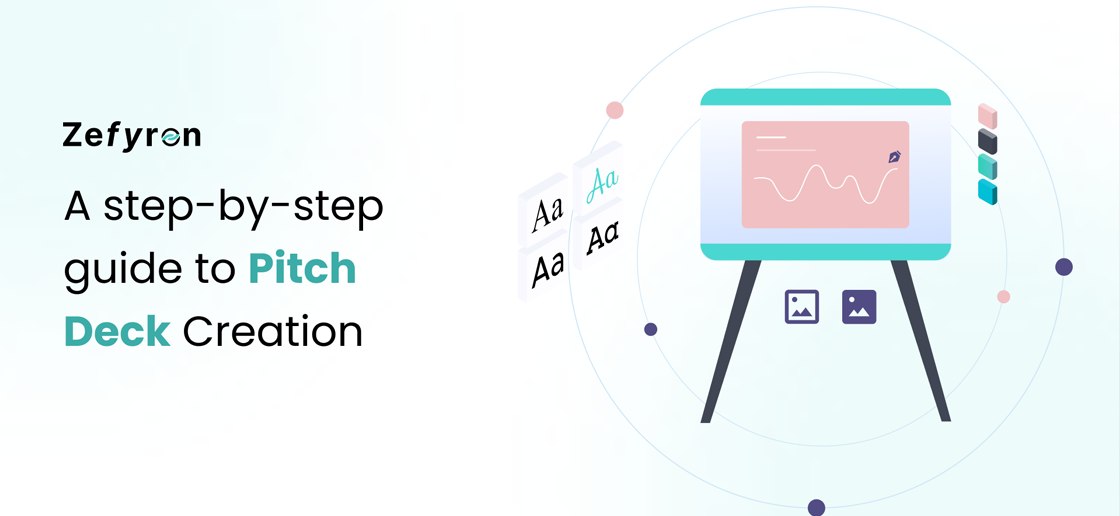A step by step guide to Pitch Deck Creation

INTRODUCTION
In the realm of business, "pitch" refers to the art of presenting a product, company, or idea to an audience in a way that captures their interest and motivates them to take action, such as making a purchase or forming a partnership. On the other hand, a "deck" is described as a comprehensive and visually engaging presentation tool that enhances a speaker's message. It is composed of a series of multimedia-rich and impactful slides that effectively convey information and deliver either a startup presentation or an investor presentation.
Overall, a pitch deck is a powerful tool that entrepreneurs and business owners use to pitch their ideas to potential investors, partners, or customers. It is a visual presentation highlighting the crucial elements of your business, such as your products, services, market opportunity, team, and financial projections.
The Pitch Deck Creation requires deliberate planning, research, and a deep understanding of your business aspects. Mentioned below is a step-by-step guide to creating winning pitch decks.
Types of Pitch Decks
- Startup pitch deck - Entrepreneurs use it to introduce their startup idea, product, or service to potential investors or partners. The goal of a startup pitch deck is to generate interest and secure a follow-up meeting or conversation.
- Investor Pitch Deck - An investor deck persuades investors to invest in a specific startup. It includes more detailed information on the company's financials, market opportunity, and growth potential. The goal of an investment pitch deck is to convince investors to make a financial investment in the startup in exchange for equity or another form of return.
- Partnership pitch deck- A pitch deck created for partnership purposes to initiate a partnership or collaboration with another company. It may include information on the benefits of the partnership, the proposed scope of work, and the key objectives
- Startup Story and Introduction
A startup story in a pitch deck is a narrative that describes how a startup was founded, the problem it solves, and the journey it took to bring its product or service to market. A well-crafted startup story can create an emotional connection with the audience, build trust and credibility, and set the foundation for a successful pitch.
- Problem
Describing the problem in a pitch deck involves clearly articulating the pain point or challenge that the target market is experiencing, supported by relevant data. It is important to differentiate the problem from existing solutions and be concise. This sets the foundation for demonstrating the value proposition and potential impact of the proposed product or service.
- Market Validation:
Target Audience, Market Size and Demand ForecastsMarket validation in a pitch deck demonstrates the demand for the proposed product or service in the target market. It reduces investment risk by validating the business model's viability. Evidence of market validation can be provided through customer surveys, market research data, testimonials, or early sales data. It is a critical component of a pitch deck and helps to build investor confidence in the business model.
- Solution :
The solution slide in a pitch deck showcases how the proposed product or service solves the identified problem and its unique features. It is concise and clear and communicates the value proposition, target market, and potential impact.
- Business Model and Financial Projections
The business model and financial projections are key components of a pitch deck that explain how the proposed product or service will generate revenue and the cost structure and provide an overview of expected revenue and expenses over a specific period of time. It is important to provide realistic and detailed financial projections to evaluate the potential return on investment and the overall viability of the business model. These components help investors make informed investment decisions.
- Competitive Analysis in Pitch Deck Creation
Competitive analysis in a pitch deck involves identifying and evaluating direct and indirect competitors in the target market and assessing their strengths and weaknesses relative to the proposed product or service. It includes a detailed overview of the competitive landscape and an analysis of the key players in the market. The goal is to demonstrate how the proposed product or service is differentiated and can capture market share.
- Ask / Call to Action
Mention clearly what you require from the audience, either funding or any other form of support.
- The problem
- The solution proposed
- The target market
- The business plan
- The team
- The pitch script is designed to communicate the value and potential of the proposed product or service in a clear and compelling way.
- Keep it simple
- Authentic and relevant data
- Shortened Content
Slides to include in Pitch Deck Creation
Curating a Pitch Script
Alongside the startup or investment PPT, the presenter must have a pitch script, i.e. a verbal outline or presentation of a business idea or proposal, typically used when seeking funding or support.
It is a structured and concise summary of the key elements of the proposed product or service, including,
Building Final Pitch Deck
Investors receive humongous applications every day; therefore it is important to stand out in the quagmire of pitch deck creation. Some tips for funding deck startups are mentioned below
Conclusion:
In conclusion, pitch deck creation is an essential part of any entrepreneur's journey. It is a powerful tool that can help you to articulate your vision and communicate your value proposition to potential investors, partners, or customers. By following the steps outlined above, you can create a compelling and effective pitch deck that will further increase your chances of success.
